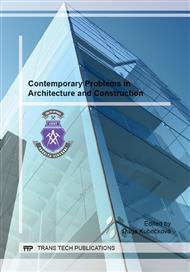[1]
CSN EN 383 Timber structures - Test methods - Determination of embedment strength and foundation values for dowel type fasteners, Czech Standards Institute, 06/(2007).
DOI: 10.3403/30149611
Google Scholar
[2]
CSN EN 1380 Timber structures – Test methods – Bearing nails, woodscrews, dowels and bolts, 12/(2009).
DOI: 10.3403/30149617
Google Scholar
[3]
Eurocode 5: design of timber structures – Part 1-1: General – Common rules and rules for buildings, Czech Standards Institute, 01/(2007).
DOI: 10.3403/03174906
Google Scholar
[4]
Mikolasek, D., Sucharda, O., Brozovsky, J., Analysis of composite timber-concrete ceiling structure by finite element method, In Applied Mechanics and Materials, volume 351-352, pp.254-259, ISSN: 1660-9336.
DOI: 10.4028/www.scientific.net/amm.351-352.254
Google Scholar
[5]
Lokaj, A., Vavrusova, K., Rykalova, E. Application of laboratory tests results of dowel joints in cement-splinter boards VELOX into the fully probabilistic methods (SBRA method). In Applied Mechanics and Civil Engineering (AMCE) 2011, Macau 12/2011, ISSN: 1660-9336, ISBN: 13978-3-03785-291-0.
DOI: 10.4028/www.scientific.net/amm.137.95
Google Scholar
[6]
Postulka J., Sandanus, J., Berechnungsverfahren für eine Holz-Beton-Verbunddecke mit nägeln als verbindungsmittel, In Bautechnik 76, 2007, Heft 11, p.1026 – 1031, ISSN 0932-8351.
DOI: 10.1002/bate.199906470
Google Scholar
[7]
Marek, P., Brozzetti, J., Gustar, M. and Tikalsky, P., Probabilistic Assessment of Structures using Monte Carlo Simulation. Praha (2003), ISBN: 80-86246-19-1.
Google Scholar
[8]
Krivy, V. & Marek, P., Kreislova, K., Knotkova, D., Bestimmung der Dickenzuschläge für wetterfesten Stahl im Brückenbau. In Stahlbau, 82. (2013), Volume 8, pp.583-588, ISSN 1437-1049.
DOI: 10.1002/stab.201310034
Google Scholar
[9]
Janas, P., Krejsa, M., Krejsa., V. Structural reliability assessment using a direct determined probabilistic calculation, In Proceedings of the 12th International Conference on Civil, Structural and Environmental Engineering Computing, CC 2009, Funchal, Madeira, 2009, ISBN 978-190508830-0.
DOI: 10.4203/ccp.91.72
Google Scholar
[10]
Konecny, P., Brozovsky, J., Krivy, V., Simulation Based Reliability Assessment Method using Parallel Computing, In Proceedings of The first international conference on parallel, distributed and grid computing for engineering, Civil Comp Proceedings, Issue 90, pp.542-549.
DOI: 10.4203/ccp.90.38
Google Scholar
[11]
Vlcek, P., Kubecka, K., Kubeckova, D., Vaculikova, H., Defects of insulation systems and their negative effect on the accumulation and energy saving, In enviBuild 2012 and Building Performance simulation Conference 2012, Brno, Czech Republic, 11/2012, volume 649, pp.143-146.
Google Scholar


